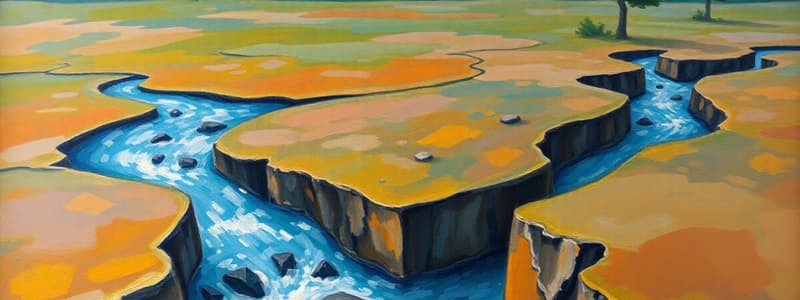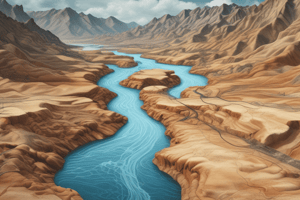Podcast
Questions and Answers
Groundwater remains static and does not move through the Earth's crust.
Groundwater remains static and does not move through the Earth's crust.
False (B)
Permeability determines how quickly water may pass through the earth.
Permeability determines how quickly water may pass through the earth.
True (A)
Clay has high permeability and low porosity.
Clay has high permeability and low porosity.
False (B)
Subduction occurs at passive continental margins leading to high tectonic activity.
Subduction occurs at passive continental margins leading to high tectonic activity.
Emergent coastlines are typically characterized by steep, rocky cliffs.
Emergent coastlines are typically characterized by steep, rocky cliffs.
The process of transpiration adds to the water vapor in the air.
The process of transpiration adds to the water vapor in the air.
Infiltration is a phase change of water in the water cycle.
Infiltration is a phase change of water in the water cycle.
Water is lost during the water cycle as it moves through different stages.
Water is lost during the water cycle as it moves through different stages.
Tectonic plates are only found in the oceanic regions of Earth's crust.
Tectonic plates are only found in the oceanic regions of Earth's crust.
Sublimation involves the change of water from gas to solid.
Sublimation involves the change of water from gas to solid.
Hydrogen bonding is responsible for water's cohesion properties.
Hydrogen bonding is responsible for water's cohesion properties.
The water cycle has three main parts: sublimation, precipitation, and transpiration.
The water cycle has three main parts: sublimation, precipitation, and transpiration.
Water molecules have a bent shape due to the space needed for unbonded electrons.
Water molecules have a bent shape due to the space needed for unbonded electrons.
Runoff describes water moving through the ground to replenish groundwater supplies.
Runoff describes water moving through the ground to replenish groundwater supplies.
Transpiration is one of the processes through which water re-enters the atmosphere.
Transpiration is one of the processes through which water re-enters the atmosphere.
Flashcards
Water Cycle
Water Cycle
The continuous movement of water on, above, and below the Earth's surface.
Evaporation
Evaporation
The process of liquid water changing into water vapor (gas).
Condensation
Condensation
The process of water vapor (gas) changing into liquid water droplets, forming clouds.
Precipitation
Precipitation
Signup and view all the flashcards
Polar molecule
Polar molecule
Signup and view all the flashcards
Hydrogen bonding
Hydrogen bonding
Signup and view all the flashcards
Cohesion
Cohesion
Signup and view all the flashcards
Porosity
Porosity
Signup and view all the flashcards
Permeability
Permeability
Signup and view all the flashcards
Groundwater
Groundwater
Signup and view all the flashcards
Tectonic Activity
Tectonic Activity
Signup and view all the flashcards
Subduction
Subduction
Signup and view all the flashcards
Active Continental Margin
Active Continental Margin
Signup and view all the flashcards
Passive Continental Margin
Passive Continental Margin
Signup and view all the flashcards
Study Notes
Groundwater
- Groundwater is water that seeps into the Earth's crust through rock and sediment.
- It is always moving, never static.
- Three factors drive groundwater flow:
- Porosity: The amount of water soil can hold.
- Permeability: How quickly water passes through the earth. Clay has high porosity but low permeability.
- Gravity: Pulls water downhill from higher to lower hydraulic gradients.
Tectonic Plates and Coastlines
- Earth's surface is made of tectonic plates (continental or oceanic).
- Plate movement causes tectonic activity, shaping land and sea.
- Active continental margins (where plates meet):
- High tectonic and seismic activity.
- Subduction occurs.
- Features: mountain ranges, oceanic trenches, volcanic activity.
- Passive continental margins:
- Low tectonic activity.
- Flat inland areas.
- Long rivers, estuaries.
- Coastlines:
- Emergent (active margins): Steep, rocky cliffs.
- Submergent (passive margins): Wide river valleys, drowned.
The Water Cycle
- The water cycle circulates water between various parts of Earth (streams, rivers, lakes, underground, seas, clouds).
- Evaporation, condensation, and precipitation are key.
- Water changes phases (solid, liquid, gas).
- Transpiration: Evaporation from plant leaves.
- Sublimation: Ice changing to vapor.
- Runoff: Water flowing across land.
- Infiltration: Water seeping into the ground.
- Energy from the sun drives the cycle, changing between kinetic and potential energy.
- The cycle is a continuous matter transfer and energy transfer.
Water Cycle Processes
- The water cycle recycles freshwater.
- Key processes:
- Evaporation: Liquid to gas
- Condensation: Gas to liquid
- Precipitation: Water falling as rain, snow, etc.
- Sublimation: Solid to gas
- Transpiration: Evaporation from plants' leaves
- Runoff: Water flowing over land
- Infiltration: Water soaking into the ground
Water Molecules
- Molecules are made of bonded atoms.
- Water (H₂O): oxygen bonded to two hydrogen atoms via polar covalent bonds.
- Bent shape due to electron placement.
- Polar molecules have partial charges (dipoles) due to uneven electron distribution.
- In water: oxygen has a negative dipole, hydrogens have positive dipoles.
- Hydrogen bonding: Strong dipoles allow water to interact with other water molecules.
- Water's polarity: Only other polar molecules dissolve in water (hydrophilic).
Studying That Suits You
Use AI to generate personalized quizzes and flashcards to suit your learning preferences.





